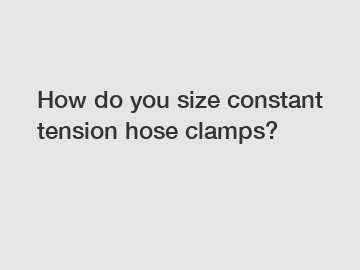How do you size constant tension hose clamps?
Constant tension hose clamps are commonly used in various industries and applications to ensure a secure and leak-free connection between hoses and fittings. These clamps offer the advantage of maintaining consistent pressure on the hose, compensating for any expansion or contraction due to temperature changes or mechanical stress. However, obtaining the correct size for constant tension hose clamps is crucial to achieve optimal performance and reliability. In this blog post, we will delve into the intricacies of sizing these clamps accurately, ensuring a perfect fit every time.
Understanding the Basics of Constant Tension Hose Clamps:
Before we dive into sizing, it's important to have a solid understanding of constant tension hose clamps. These clamps are designed with a spring mechanism that allows them to automatically adjust tension as the hose expands or contracts, thereby maintaining a consistent pressure throughout. They are typically made from stainless steel, ensuring durability and resistance to corrosion.

Factors to Consider While Sizing Constant Tension Hose Clamps:
1. Hose Diameter:
The first step in sizing hose clamps is to measure the diameter of the hose correctly. Measure the outer diameter of the hose where the clamp will be positioned. Consider the hose material and its potential expansion or contraction under normal operating conditions. Note that constant tension hose clamps are available in various size options, ensuring compatibility with a wide range of hose diameters.
2. Hose Material:
Different types of hoses may require specific clamps due to varying thickness or flexibility. It is crucial to consider the material of the hose and its resistance to extreme temperatures, chemicals, and pressure fluctuations. Gathering relevant information about the hose material will help you choose the most appropriate constant tension clamp for your application.
3. Application Requirements:
Take into account the specific requirements of your application. Factors like operating pressure, temperature range, and vibration levels can affect the selection of the right constant tension hose clamp. Consider the potential stress the hose may undergo during operation and choose a clamp that can handle the demands of your particular situation.
4. Industry Standards and Regulations:
Adherence to industry standards and regulations is important to ensure safety and compliance. Depending on the application, certain industries may have specific requirements for hose clamps. Understanding and following these guidelines will help you make the most informed choice when it comes to sizing constant tension hose clamps.
Sizing Constant Tension Hose Clamps:
Once you have gathered the necessary information, it's time to determine the appropriate size for your constant tension hose clamps. Several sizing methods are commonly used:
1. Manufacturer's Guidelines:
Check the manufacturer's guidelines and instructions for sizing recommendations. Reputable and trustworthy manufacturers often provide detailed information on the compatibility of their hose clamps with specific hose sizes and materials.
2. Online Sizing Tools:
Many manufacturers offer online sizing tools, allowing you to input details such as hose diameter, material, and other specific requirements. These tools can assist in calculating the right clamp size and provide valuable product recommendations based on your inputs.
3. Consult an Expert:
When in doubt, consult an expert or reach out to trusted suppliers. Professionals in the field possess extensive knowledge and experience and can guide you in selecting the best clamp size for your specific needs.
Conclusion:
Accurate sizing is crucial for ensuring the reliability and effectiveness of constant tension hose clamps. By considering factors like hose diameter, material, application requirements, and industry standards, you can choose the right clamp size that will provide a secure and leak-free connection. Rely on manufacturer guidelines, online sizing tools, or consult experts to make an informed decision. By taking these steps, you can confidently select and install constant tension hose clamps that will meet your needs and expectations.
Are you interested in learning more about down-lead, opgw tension assembly, opgw splice box? Contact us today to secure an expert consultation!

Comments
0